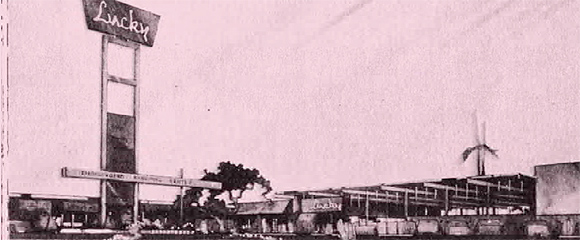Located on Embarcadero Road at Highway 101, Edgewood Shopping Center marks a gateway to Palo Alto, the Palo Alto Baylands, and Stanford University. It is also the center of a universe. This is where visionary developer Joseph Eichler built two of his early residential subdivisions in his distinctive mid-century modern style. Here he also built the Edgewood Plaza Shopping Center to serve the new homeowners. And, within the mixed-use Edgewood complex, Eichler established his business headquarters, centered amidst the burgeoning suburban culture of Palo Alto of the 1950s and ‘60s.
Eichler engaged the architecture firm of Jones and Emmons to design Edgewood Plaza. A. Quincy Jones was an influential designer and educator. He is recognized as a leader of California modern architecture and for many years was the Dean of Architecture at the University of Southern California (USC), a center of progressive design in the postwar years. Jones, who devoted much of his career to community planning, designed the Edgewood Plaza to fit with the nearby Eichler neighborhoods, which he also helped to plan. Jones is responsible not only for the clear and effective planning of the Center, but also for its elegant architectural form. Designed for the efficient and comfortable use of shoppers arriving by car, the Center is also pedestrian-friendly. Full height glass walls and partially covered exterior courts allow connections with the landscape and climate. Post and beam structures enable long, low slung roofs with deep overhangs that keep the overall profile unimposing while exploiting the expressive potential of this building technology to create the illusion of soaring, seemingly weightless forms. Edgewood remains a vital example of suburban commercial architecture. Alan Hess, architecture critic for the San Jose Mercury News, wrote two years ago that Edgewood “is still one of the most innovative, best designed shopping centers in the state.”
Palo Alto is Eichler central. Over 2,500 Eichler homes were built here, spanning almost the length of Eichler’s developer career. Edgewood Plaza is unique among his accomplishments, the only commercial development designed as an integral part of a residential neighborhood, lending it added historic significance. Civic leaders across the country have recognized and exploited the value of distinctive vintage shopping centers and districts, investing in preservation and revitalization efforts that have attracted new users and re-inspired civic pride. A restoration of Edgewood Plaza would likewise add prestige to Palo Alto, preserving and promoting the City’s modernist heritage. Equally important, Edgewood’s restoration will improve the revenue-making potential of the center, resulting in valuable tax generation.
Joseph Eichler’s Edgewood Plaza is an icon of Palo Alto’s mid-century modern legacy. Not only an integral part of its community, this innovative complex is, as well, a precious cultural resource—a nationally significant example of enlightened and holistic suburban design. Edgewood’s fate will serve as an important gauge of Palo Alto’s contemporary civic values.
Author Paul Adamson, AIA, is an architect and co-author of Eichler: Modernism Builds the American Dream. He is a founding member of the Northern California working party of DOCOMOMO (Documentation and Conservation of the Modern Movement) an intentional modernist preservation group devoted to education of the principles of the modern movement and preserving its built works. Mr. Adamson has written several articles on mid-century design, including an essay on postwar American planning for the book, The Modern City Revisited, published by SPON Press in 2000, and articles on the Eichler Homes for Echoes magazine and the London-based academic quarterly, Journal of Architecture. Since 1994 he has been a design architect with the San Francisco-based firm, Hornberger + Worstell, where he is a senior associate.
Originally published 2nd quarter 2005, in arcCA 05.2, “Other Business.”






